
Today we’re taken on an awe inspiring trip through Aya Sofya with Karen at the Turkish Delight blog.
Ok. I’m finally going to take it on. Aya Sofya (Turkish). Or Hagia Sophia (Greek). (Both pronounced “EYE-uh sof -EE- uh”, meaning holy wisdom) It’s got to be one of the most famous buildings in the world. And it’s been in my top five of places to visit for years. I still reel a little bit when I remember that I actually went there. It’s so influential, and huge, and beautiful, and old. And intact. That’s probably the most amazing thing. It was completed in 537 under the Byzantine Emperor Justinian, and it more or less stands as it did then.
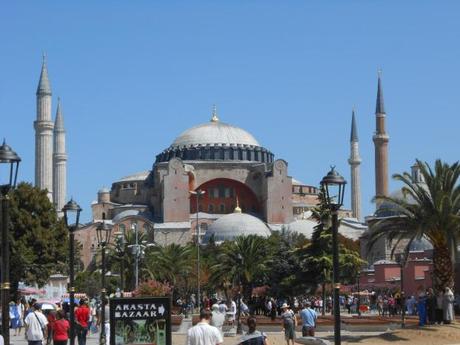
Aya Sofya, 6th century, Istanbul
The existing building is the third one on the same site. (The other two burned down). One of my favorite things there was this relief from the second church, innocently sitting outside the entrance in a sort of ditch. Isn’t it beautiful, kind of ancient Near Eastern in feel?
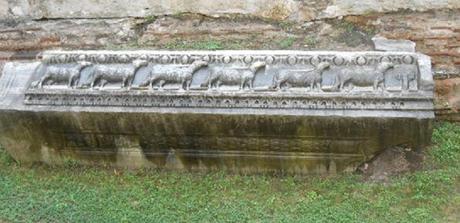
From the second Aya Sofya, 5th century AD, part of front entrance of second church
So it was built as a church by the Christian Byzantine Emperor Justinian. Then when the Ottomans conquered what was then Constantinople in 1453, they turned it into a mosque. In the 1930s, Ataturk secularized it and turned into a museum.What is striking about Aya Sofya is that you can see both Muslim and Christian art in the same (formerly) religious space. The mihrab, which shows the direction of Mecca, while usually an integral part of a mosque, was tacked onto the apse here, in the same space where the Christian altar would have been.
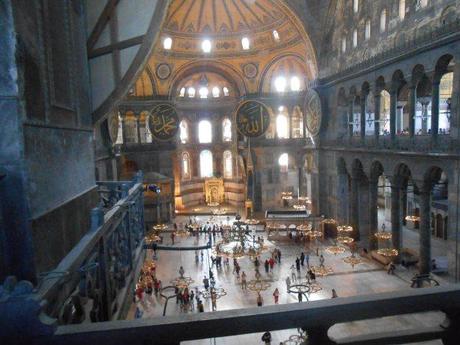
Aya Sofya, 6th century, Istanbul. The mihrab is in the center of the picture, at the end of the building, a bit off center.
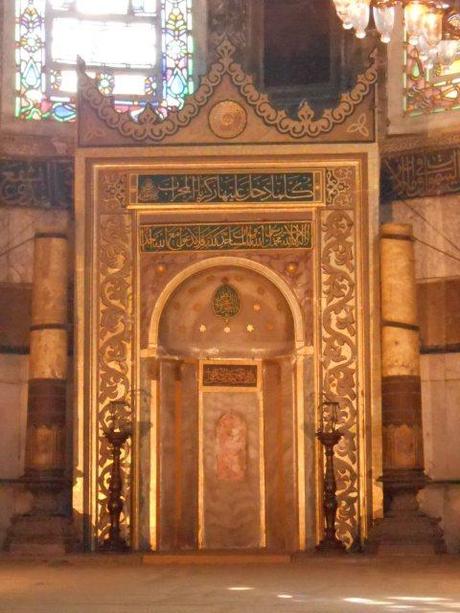
Mihrab, 18th century, Aya Sofya, Istanbul
The Muslims whitewashed over many of the 9th and 10th century Christian mosaics rather than destroying them, and many of them have been restored. Below is one of my favorites. Justinian presents his church (Hagia Sophia, on our right) and Constantine presents his city (Constantinople, on our left) to Mary and Jesus. Neither model looks anything like the real thing, but I like the concept.
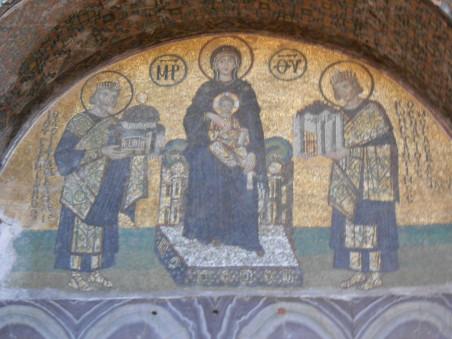
Left, Constantine with model of Constantinople; center, Mary and Jesus; right, Justinian and model of Hagia Sophia, 10th century
And this one is just plain beautiful, even if it is partially destroyed:
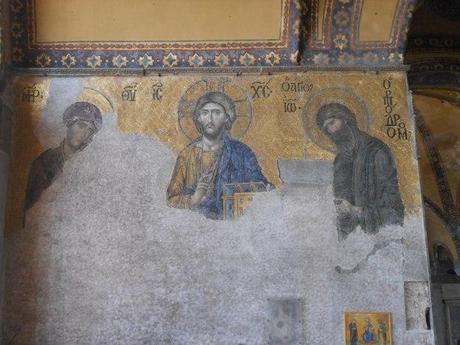
Look at the emotion in the face of John the Baptist, in particular:
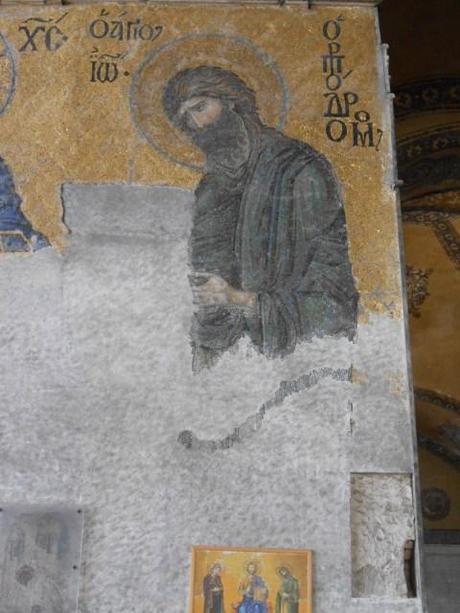
John the Baptist from the Deesis mosaic, 13th century, Aya Sofya, Istanbul
Some mosaics still exist from Justinian’s time (6th century), including the ribs of the dome:
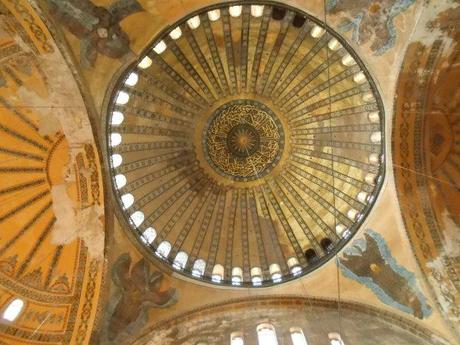
Dome, Aya Sofya, 537 AD,Istanbul,
Visiting Aya Sofya was awe-inspiring. And crowded. And hot. But mostly just simply amazing. I stood there, thinking about Justinian and Theodora being here in 537, and Mehmet the Conqueror entering in 1453, and all of the other people who must have seen the building from the Bosphorus
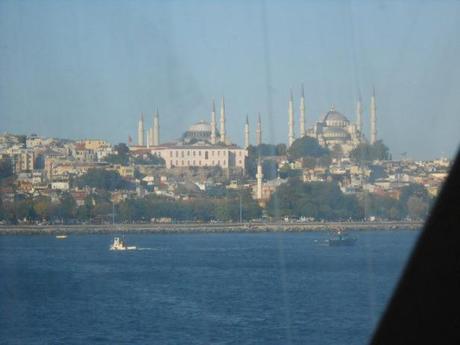
Aya Sofya (on the left) from the ferry, Istanbul, August 2012
or from the street, and gone inside, staggered by its size
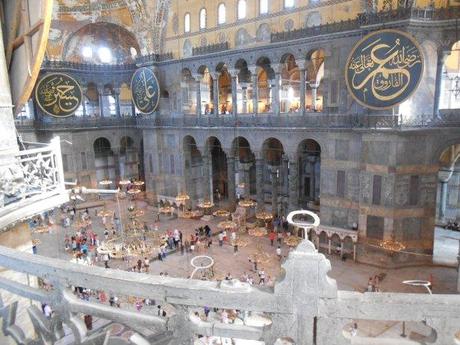
Aya Sofya, 6th century, Istanbul
and dazzled by its opulence.
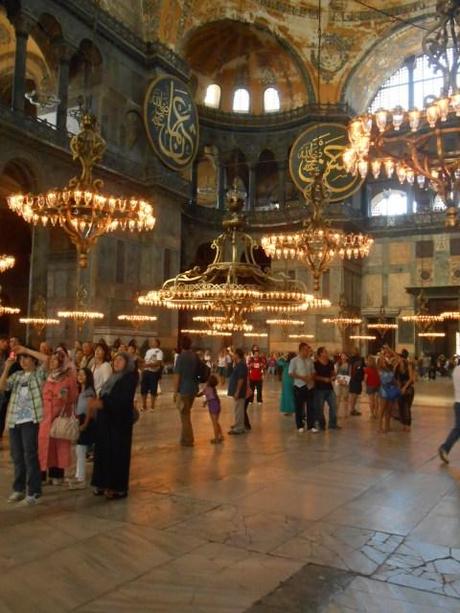
Aya Sofya, Istanbul
And clearly, a lot of people have been inside!
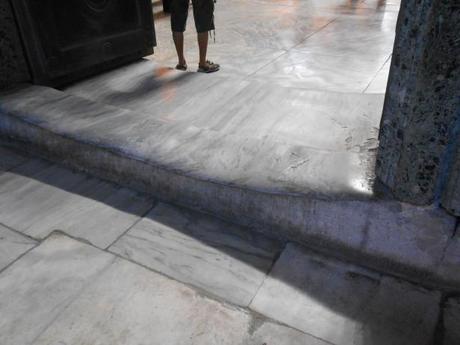
Aya Sofya, Istanbul, worn step, August 2013
Finally, one of my favorite parts was these slices of porphyry columns and marble panel:
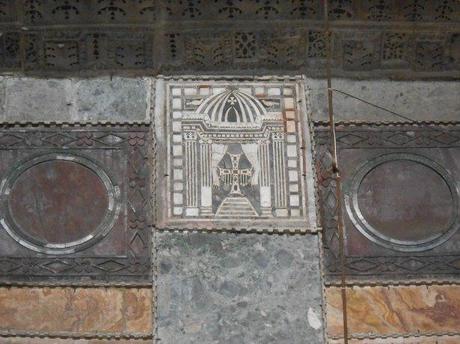
Porphyry roundels with panel depicting ciborium, Aya Sofya, Istanbul
You could spend hours here. Everywhere you look, something intriguing, or startling, or simply beautiful. Next time I’m going to lie down on the floor and just be (and try not to get trampled!).
If you go, go early. I got there at about 9am and it was already getting hot and crowded. Somehow it didn’t really matter, though. It’s such a vast space with so much vertical area, that it didn’t feel overwhelmingly full of people. You spend a lot of your time looking up, so that helps. This was not, for me, one of those places or objects that I’ve seen reproduced so many times that when I finally see it, it’s a let-down. Aya Sofya was not a let-down. It has got to be as magnificent as it was when it was built, maybe even more so, when you add on the layers of the centuries.
If you want more, check out this fascinating post at Daydream Tourist about the trompe l’oeil (trick of the eye) murals inside. The more you look, the more you find. You will not be disappointed!
(Title from quote by Paul the Silentiary, a court official of Justinian, about Aya Sofya: ” . . . it seemed as if the mighty arches were set in heaven.” Hilary Sumner-Boyd & John Freely, Strolling Through Istanbul. Istanbul: Redhouse Press, 1972, p. 41)
Entry Fee: 10 YTL
Location: Aya Sofya Square Sultanahmet, Istanbul, Turkey
